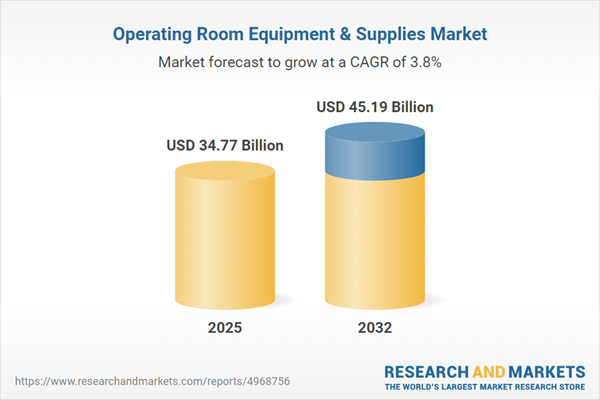Speak directly to the analyst to clarify any post sales queries you may have.
Senior healthcare executives face increasing complexity when planning operating room investments. To maintain competitive advantage, they must achieve a careful balance between adopting new surgical technologies, maintaining regulatory compliance, and optimizing procurement models in a high-stakes clinical setting.
Market Snapshot: Operating Room Equipment & Supplies Market
The global operating room equipment and supplies market reached USD 33.47 billion in 2024 and is projected to rise to USD 34.77 billion by 2025, representing a compound annual growth rate of 3.82%. Current growth is fueled by rapid adoption of digital platforms and advanced surgical technology in hospitals and ambulatory sites. Healthcare organizations are prioritizing workflow efficiencies and reinforcing safety standards through these investments. Procurement and operational leaders continue to seek adaptable and interoperable solutions as care delivery models evolve. The operating room equipment and supplies market is shaped by ongoing requirements for efficiency, compliance, and the flexibility to respond to shifts in patient demand and procedural complexity.
Scope & Segmentation of the Operating Room Equipment and Supplies Market
This report provides actionable segmentation and strategic market intelligence for procurement and operations leaders guiding investment decisions. Senior decision-makers gain insights to match equipment choices with organizational priorities and clinical objectives.
- Equipment Types: Anesthesia machines, electrosurgical units, endoscopy systems, C-arms, fluid warmers, sterilization systems, integration modules, forceps, scalpels, surgical lighting, and operating tables support a broad range of surgical needs, enabling procedural versatility.
- Technologies: Innovations such as minimally invasive devices, robotic-assisted systems, and digital integration are streamlining perioperative precision, communications, and quality assurance for multidisciplinary teams.
- Applications: Serves specialties across cardiology, orthopedics, neurosurgery, urology, general surgery, and laparoscopy, affording procurement leaders the ability to align resource allocation with ever-changing clinical requirements.
- End Users: Hospitals, ambulatory surgery centers, and specialty clinics adopt tailored procurement models to match varying case types, patient throughput, and strategic goals.
- Geographical Coverage: Regional examination spans the Americas, Europe, Asia-Pacific, and the Middle East & Africa, with attention to regulatory landscapes, infrastructure capacity, and differing investment trends impacting equipment strategies.
- Company Coverage: Features analysis of key operators such as Medtronic plc, Stryker Corporation, Johnson & Johnson, and Siemens Healthineers AG, focusing on innovative product lines, market positioning, and strategic partnerships that foster market stability.
Key Takeaways for Senior Decision-Makers
- Adopting agile procurement models ensures readiness for new regulatory shifts and changing supply chain realities, helping sustain timely access to vital surgical equipment.
- Integrating advanced digital and robotic technologies enhances workflow efficiency, supports multidisciplinary collaboration, and contributes to improved patient safety and surgical quality.
- Ongoing partnerships with suppliers, coupled with investments in research, keep organizations attuned to current clinical protocols and compliance needs.
- Deploying modular operating room designs offers flexibility for cost management and swift adaptation as service lines or clinical programs evolve.
- Holistic technology integration streamlines adherence to regulatory requirements and speeds modernization of the surgical environment.
- Structured reviews of infrastructure and supplier performance strengthen operational prep for future care models and expanded service offerings.
Tariff Impact on the Supply Chain
Recent tariff changes in the U.S. have prompted healthcare providers to focus on expanding domestic supplier relationships and pursuing diversified sourcing options. Distributors are responding by updating contract frameworks and optimizing inventory management processes to reduce exposure to risk and maintain continuity despite volatile global supply chain conditions.
Methodology & Data Sources
This report is built on structured interviews with surgeons, operating room managers, procurement specialists, and compliance professionals. Insights are validated via comprehensive literature review, patent analyses, and market research, ensuring actionable data for strategic planning.
Why This Report Matters for Senior Operating Room Decision-Makers
- Delivers segmented market analysis to strengthen procurement, manage risks, and ensure alignment with shifting industry standards and regulatory expectations.
- Facilitates timely evaluation of emerging surgical technologies and supplier advancements to drive operating room modernization efforts.
- Empowers organizations to plan and adapt quickly to new patient care standards and ongoing changes in clinical practice.
Conclusion
This report is an essential reference for leaders driving procurement, operational resilience, and continuous advancement in surgical care amid dynamic healthcare market changes.
Additional Product Information:
- Purchase of this report includes 1 year online access with quarterly updates.
- This report can be updated on request. Please contact our Customer Experience team using the Ask a Question widget on our website.
Table of Contents
3. Executive Summary
4. Market Overview
7. Cumulative Impact of Artificial Intelligence 2025
Companies Mentioned
The companies profiled in this Operating Room Equipment & Supplies market report include:- Medtronic plc
- Stryker Corporation
- Johnson & Johnson
- B. Braun Melsungen AG
- Zimmer Biomet Holdings, Inc.
- Baxter International Inc.
- Cardinal Health, Inc.
- Getinge AB
- STERIS plc
- Siemens Healthineers AG
Table Information
| Report Attribute | Details |
|---|---|
| No. of Pages | 185 |
| Published | October 2025 |
| Forecast Period | 2025 - 2032 |
| Estimated Market Value ( USD | $ 34.77 Billion |
| Forecasted Market Value ( USD | $ 45.19 Billion |
| Compound Annual Growth Rate | 3.8% |
| Regions Covered | Global |
| No. of Companies Mentioned | 11 |









